Bavarian timber formwork pros set industry standards for complex construction tasks
Building specialised formwork for hydropower plant construction requires both relevant expertise and skilled craftsmanship. These attributes form the basis for crafting what is sometimes highly complex formwork for intake pipes, elbows, cones and intake spirals. Over the past decades, the Bavarian formwork specialists at Mitterfelner Schalungsbau have established their company’s reputation as a key provider in the sector. Mitterfelner has been supplying customised timber solutions for hydropower plant construction almost 30 years; ones that are both easy to assemble and to dismantle. In order to render complex shapes clearly at the planning stage the Bavarians are increasingly turning to precise scaled-down 3D models, produced with a 3D printer. Specialised formwork manufactured by Mitterfelner Schalungsbau is now in use all over the world.
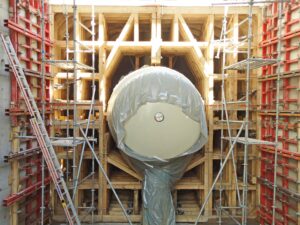
© Mitterfelner
One of the most challenging tasks in hydropower plant construction remains the question of how to shape concrete with formwork. After all, this requires the production of curved, occasionally twisted shapes, with radii that are not always constant, as well as transitioning perfectly from rectangular to round cross-sections. In the vast majority of cases customised formwork is the only solution used in the hydropower industry. Today, very few companies around the world master this craft, or have enjoyed sustained success in the field. The Bavarian company Mitterfelner Schalungsbau is one of the very few, and has been supplying specialised formwork for hydropower since 1996. The company’s expertise is explained by its history. The founding family has been operating its own hydroelectric power plant for several generations. In the mid-1990s conversion work became necessary, and provided the initial impetus for the company to increase its concentration on the construction of special formwork. Construction of formwork is still primarily a manual task and a highly specialised area of the traditional carpentry trade – one that Mitterfelner has practised very successfully for decades. “As we feel a strong connection to hydropower, we are always well informed about the latest trends and standards in this sector. In turn, this has enabled us to expand our expertise over the years,” says Robert Prielmeier, Managing Director at Mitterfelner Schalungsbau.
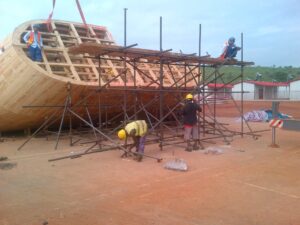
© Mitterfelner
Supported by 3D modelling
Mitterfelner has also continued to develop its planning capabilities for complex special formwork. “As in other industries, 2D planning has long since given way to physical 3D rendering, and is carried out with the help of the latest CAD programmes. True-to-scale 3D-printed models can be extremely useful. Now, a highly representative model is the best possible means of helping everyone involved in production to visualise complex geometries,” Robert Prielmeier explains.
Such a model’s importance is particularly evident in formwork crafted for an inlet channel. Quite often, even the most experienced formwork builders at Mitterfelner Schalungsbau face major challenges. Complex geometries must be fine-tuned to previously installed turbine inlets. “All load forces must be transferred to the outside to ensure there is no pressure on the steel components. For this reason our formwork is built from solid wood in a framework structure, and dimensioned sufficiently to withstand the concreting process,” the Managing Director states. Each individual element of the formwork is fully braced, eliminating the necessity for any subsequent construction site bracing.
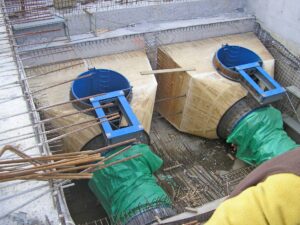
© Mitterfelner
Hydraulically optimised inlet
Not least for sake of sustainability, Mitterfelner Schalungsbau’s pros use regionally-sourced, untreated timber. Among several advantages, used timber formwork can be disposed of very easily, and the absorbance of the surface of the wood ensures concrete is harder, more resistant and sets with fewer air pockets. The surface of the planed formwork boards is evened and sanded by hand to create the smoothest possible surface, allowing the formwork builders to guarantee optimum hydraulic conditions and maximum system efficiency within the future water conduit. The supreme quality of Mitterfelner Schalungsbau’s special formwork enables it to be reused. The robust and highly functional connecting system facilitates simple assembly, and makes dismantling easy too. Formwork elements are delivered to the site on trucks, sea containers and even cargo helicopters – divided into individual components whose size is, as a rule, determined by transport dimensions.
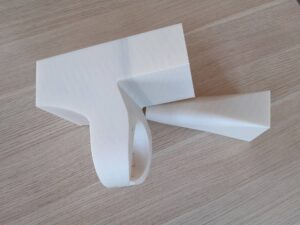
© Mitterfelner
In use around the world
The Bavarian formwork builders’ expertise is in great demand especially for power plant conversion projects. Robert Prielmeier: “If the suction pipe requires adaption, formwork must be inserted into the existing suction hose. This demands intensive planning work in order to produce viable formwork, to facilitate reinforcement and ensure sufficient concrete cover in the tightest of spaces.” There are good reasons for making Mitterfelner Schalungsbau the first port of call when planning and producing premium quality suction pipe moulds, curved moulds, inlet and cone moulds and casts for spiral inlet chambers. The Bavarians can now point to more than 230 successfully completed reference projects. Mitterfelner Schalungsbau’s specialised formwork is regarded as an industry quality seal and a reliable foundation in hydroelectric power plant construction – be it a high-alpine pumped storage power plant, such as the Obervermuntwerk in Vorarlberg, run-of-river power plants on the Inn and Mur rivers, in generally throughout Europe or in Africa.
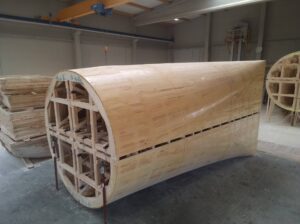
© Mitterfelner